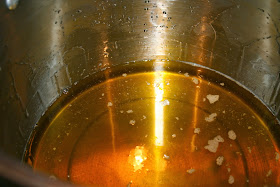We are now ready to combine the lye water and oils together. This part is dangerous because the lye water is involve. As I mentioned in Part I, it is best to do this when you are home alone. If that is not possible, mix the soap in a room where you can lock the door and not be disturbed. ALWAYS think safety first.
I mix my soap on my kitchen floor to limit any damage if I spill it. I never have spilled it in 20 years but since this is one of my safety practices, I continue to do it this way. Here is a picture of my kitchen floor on a normal day at my house.
At this point in the process, I am ready to go get the lye water from the garage. Be sure to put your rubber gloves back on (and the goggles too) before you pick up the container of lye water. Pour the entire contents of the lye water into the oils. Pour slowly or it will splash. Now, stir the pot with a plastic spoon for a few minutes.
Notice I have two spoons in my hand? One of the spoons is from the lye water and the other is from the oil pot. The same with the thermometers. After a few stirs, (and when the spoon stops dripping), I place one of the spoons back into the lye water container because two spoons aren't necessary. When the thermometers stop dripping, they go into the lye water container as well. I follow this process to prevent drips from spilling either on the newspaper or any part of the floor not covered. At this point, I set the lye water container aside and concentrate on the soap pot.
After stirring for a few minutes, it is time to use the stick blender.
I normally don't hold the spoon and stick blender in the same hand but to take the picture I had to hold the camera too! My experience with the stick blender is that it has a lot of potential to splash the soap around the pot (and onto your face) if you don't submerge the entire blade and blade cover into the pot first. Three or four short 5 second bursts are all that is needed here. Then stir with the spoon for one more minute. Three or four more blasts on the stick blender again and it is time to add the scented oil. If you wanted to add color, now is the time to do that as well. I also add the super fat oil now.
Stir with the spoon for one more minute. Use the stick blender again for one to two minutes until the soap traces. Trace is the stage of the process that tells you the soap is ready to go into the mold. The soap will get thick like you are making instant pudding but before it sets. When a spoonful of soap dribbles back into the pot and you can see where it landed, you are at trace. Depending on the recipe and the scented oils, it could take three or four minutes to trace. If it takes longer then a minute or two, I usually stop and stir again with the spoon but it really isn't necessary. You can use the stick blender until it traces. Here is a picture of my soap at the trace stage.
Pour it into the soap mold. Pour slowly so it doesn't spill or splatter. Once in the soap mold, I usually even the soap out, similar to what you would do with cake batter when you pour it into the pan.
Now that the soap is set in the mold, it is time to wash the soap pot and lye water container. I usually wash the lye water container in my sink in the laundry room. Same with all the other utensils and containers. Sometimes, I will let the soap pot sit until the next day and wash it then. If I do that, I lock it in the garage overnight so no one can get to it. Then I just wash it in the kitchen sink.
The soap needs to sit undisturbed for about 24 hours. Remember, it needs to complete the chemical process of making the soap. To do this, it must heat up. If you interrupt the process and take the soap out of the mold while it is still warm, the chemical process isn't finished and there could still be lye in the soap. (If you weighed all the ingredients correctly and waited for the soap to completely cool before taking it out of the mold, the lye isn't there any more.)
My rule of thumb is if the newspaper is still warm, the soap isn't ready. Wait until the newspaper is completely cool before you unwrap the soap. I stick my hand under the towels to see if the newspaper is warm. I usually make my soap in the afternoon. Then the soap can heat up all night. I check it at lunch the next day and take it out of the mold after lunch. This gives the soap about 22 hours to complete the chemical process. It comes out perfect every time!
Next, I will cut the soap and share some of my recipes!
If you liked this post, you may also like:



































